Senna, Fan Xie Ye 番泻叶Fan Xie Ye (TCM)Svarna-pattri, Markandi (Ayurveda) Sanna (Unani) |

|
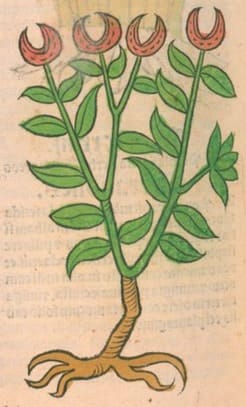 Ortus Sanitatis, Meydenbach, 1491
Ortus Sanitatis, Meydenbach, 1491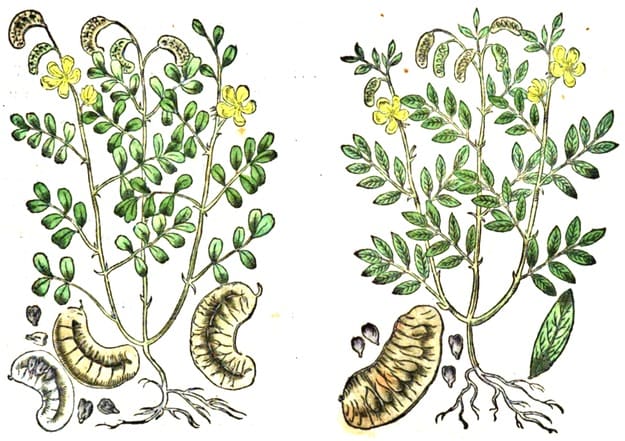 Left: Indian Senna (C. angustifolia); Right: Alexandrian Senna (C. acutifolia)
Left: Indian Senna (C. angustifolia); Right: Alexandrian Senna (C. acutifolia)Kreutterbuch, Matthiolus, 1586
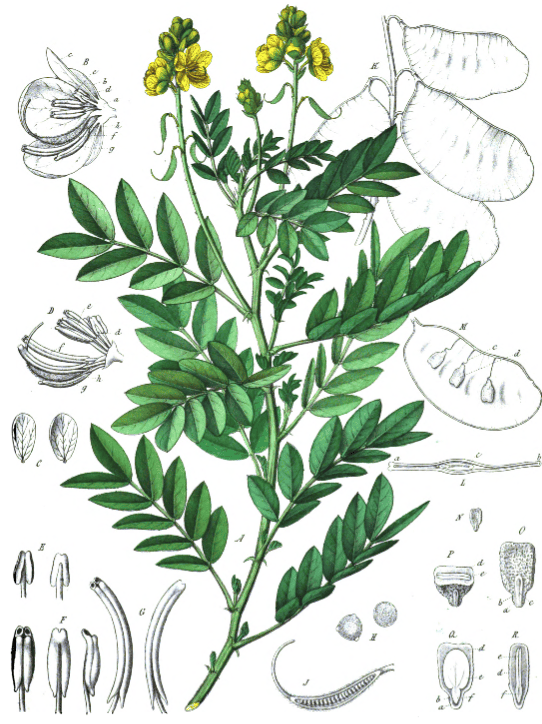 Cassia acutifolia
Cassia acutifoliaAtlas der officinellen pflanzen (2), Felix, 1899 |
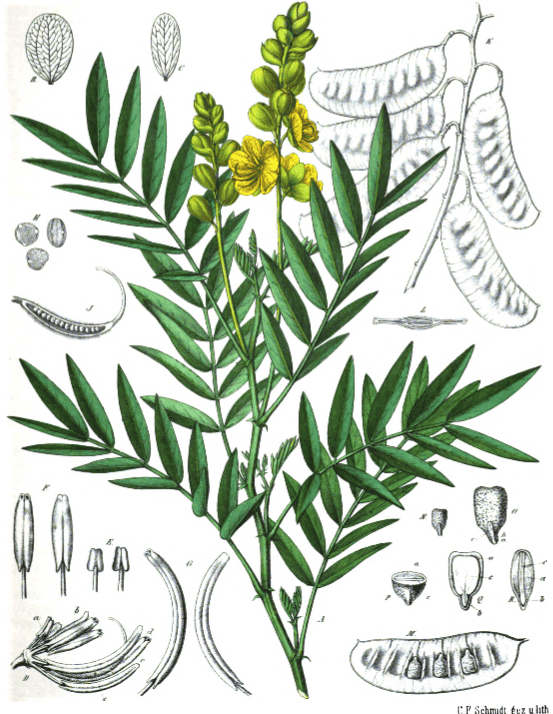 Cassia angustifolia
Cassia angustifoliaAtlas der officinellen pflanzen (2), Felix, 1899 |
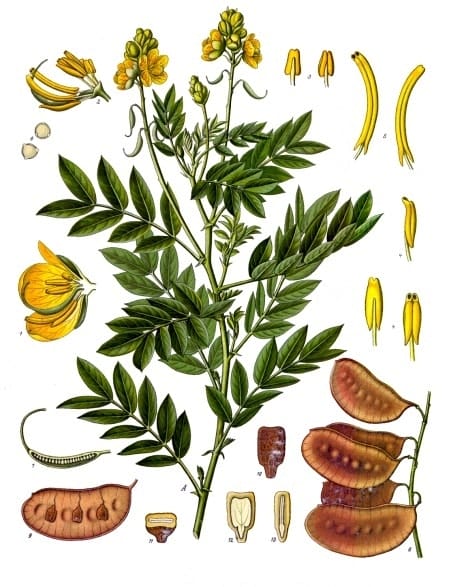 Alexandrian Senna
Alexandrian Senna(Köhler’s Medizinal-Pflanzen, 1897)
Botanical name:Cassia spp.
Parts used:Leaf; Pods Temperature & Taste:Cold, dry. Bitter, Sweet Classifications:2A APERIENT. 2F. PURIFYING. 2G. CLEANSING 3Q. ANTHELMINTIC 4f. SPLENETIC |
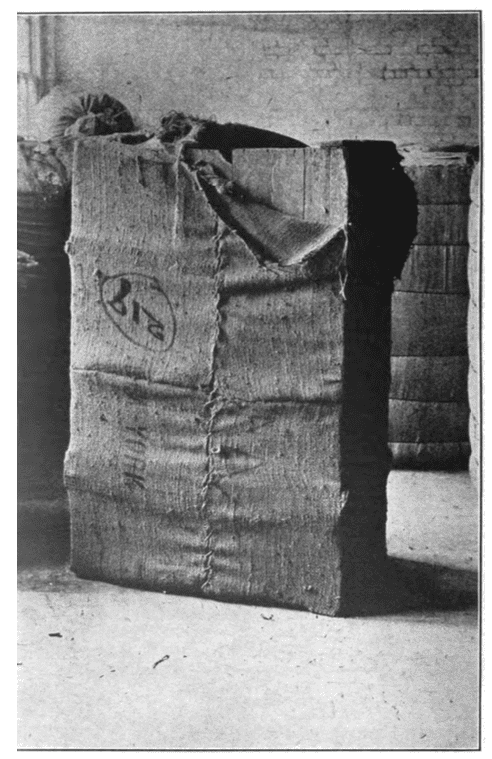 Alexandrian Senna, Squibb’s Atlas
Alexandrian Senna, Squibb’s Atlasof the Official Drugs, Mansfield, 1919 |
Uses:
1. Clears Heat, Opens Obstructions, Promotes Stool:
-acute constipation from excess heat in the Intestines.
-abdominal fullness, especially in habitual constipation.
-aids detoxification in conditions such as skin disorders.
-Its ‘downward’ effect can be used to promote menstruation, and guides heat down from the upper body as Rhubarb does.
-Pancreatitis, Cholecystitis, as well as heat-type gastrointestinal bleeding etc.
-taken in small doses in apoplectic coma, facilitates recovery.
2. Purges Melancholy:
-Senna was much used by Greek, European and Persian physicians to purge the Melancholy humor.
-chronic skin diseases, Fibroid tumors, mental illness
-it clears the Mind when affected by excess Humors
3. Clears Damp, Promotes Urine:
-Edema, Ascites
-obstructed Urine
Dose:
1. Senna should not be boiled. If added to a decoction, they are added just before removing from the heat and steeped in the hot decoction for 10 minutes before straining.
2. An Infusion in warm water is often regarded as the best preparation.
3. Sylvius noted that Senna is a mild medicine when given in powder or infusion, but will cause griping if given in Decoction.
4. The leaf is stronger, weight for weight, than the Pods, even though the pods have a higher anthraquinone content. Some have stated the pods are equally effective as the leaves, but work more slowly.
5. Small doses of 1-2 grams produce normal or loose stool in 5-7 hours; moderate doses of 3-6 grams act more quickly, but may cause pain and griping, and watery stool; large doses of 8-12 grams causes severe pain and griping, and may also result in nausea and vomiting, along with violent diarrhea within a few hours.
6. Purgatives such as Senna, Rhubarb and Aloe were often combined in formulae, rather than using a larger dose of a single herb. In addition, carminatives are added to reduce griping while strengthening the effects. This is traditionally referred to as ‘Correcting’. Most commonly used are Aniseed, Fennel, Caraway, Cumin, or spices such as Ginger, Cinnamon, Pepper etc.
7. Senna combines well with Epsom salts (and other Saline Purgatives), as this will prevent griping, but enhance the effects. It was often used with Cream of Tartar, which was claimed by some to be the best Corrector of Senna; aiding its positive effects while eliminating its unwanted effects.
8. Europeans sometimes use de-resinated Senna leaves. These are milder in function, reduce the chance of griping and irritation, but also reduce the laxative effect. They are better for children and people with a sensitive or irritated stomach or intestines
Powder: 1–3 grams
Infusion: 2–4 grams
Decoction (added towards the end): 3–6 grams (rarely more)
Correctives:
1. Corrected with Ginger, Cinnamon, Greater Cardamon, Clove or Nutmeg
2. Or with Cumin, Caraway, Fennel seed, Aniseed etc.
Main Combinations:
1. Constipation:
i. Senna with Fennel seed, as in Syrup of Senna
ii. Senna with Prunes, Linseed, Aniseed, Fennel seed
iii. Senna with Rhubarb, Gentian, Spikenard
2. To purges Phlegm and Melancholy, Senna with Cream of Tartar, Ginger, Cinnamon and Rock Salt (as in Senna Powder)
3. Wind, Colic, obstructions of the Bowels, Womb, Kidneys, Spleen and Bladder, Senna with Aniseed, Caraway, Fennel, Cumin, Spikenard, Cinnamon, Galangal, Licorice (as in Powder of Senna Greater)
4. To Purge Melancholy, Senna with Polypody, Ginger, Raisin, Prune, Borage, Violet, Rose and Rosemary (as in Decoction of Senna)
5. To purge Phlegm and Melancholy from the Head, for Headache, Senna with Dodder, Polypody, Turbith, Violet flower, Ginger (as in Electuary of Senna, of Unani)
6. Constipation with Indigestion, Senna with Chebula, Black Pepper, Rose and Raisin (as in Pills of Senna, Unani)
7. To purge Phlegm and Bile, in Jaundice, Scrofula etc., Senna with Rhubarb and Agaric (as in Blessed Extract)
8. Melancholy, Madness and for chronic Skin diseases, Senna with torrefied Hazel nuts, Silkworm cocoons, Lapis Lazuli, Cinnamon, Clove, Indian Spikenard, Basil seed, Saffron, Rosemary (as in Electuary of Senna of Nicholas)
9. Apoplexy and Paralysis, Senna with Turbith, Juniper berry, Zedoary, Agaric, Galangal, Ginger, Cinnamon, Lavender, Calendula (as in Apoplectic Wine)
10. Elixir of Health, Senna with Guaiacum, Elecampane, Aniseed, Caraway, Coriander seed, Licorice, Raisin
11. To benefit Memory, Senna with Zedoary, Cumin, Dill seed, Ginger, Clove, Nutmeg, Calamus, Sage, Rue, Valerian, Aniseed (Wirtzung)
12. Purgative for Worms, Senna leaf, Buckthorn bark, Wormwood, Mint, Camomile (Ulrich)
13. To make the hair black, Senna with Henna
Major Formulas:
Infusion of Senna and Flower with Spices (Mesue)
Decoction of Senna
Syrup of Senna Comp.
Powder of Senna (Montagna)
Powder of Senna with Flowers (Mesue)
Powder to Purge Melancholy (Mesue)
Powder of Three Solutives (Augustine Pharmacopoeia)
Special Powder for Memory (Wirtzung)
Electuary of Senna (Disenna) (Nicholas)
Electuary for the Joints (Unani)
Electuary for Scabies and Pruritis (Rhasis)
The Queen of Colen’s Electuary
Imperial Pills
Magisterial Imperial Pills
Pills of Fumitory and Senna (Unani)
Elixir Salutis, Elixir of Health
1. Laxative Powder:
i. Senna, Aniseed, White Sugar, Cream of Tartar (of each 1 oz.). Mix. (Pharmacopoeia Oldenburgica, 1801)
ii. Senna leaf (16 parts), Cream of Tartar (4 parts), Fennel seed (2 parts), Cinnamon, Mace (1 part each). Dose: 1 dram. (Pharmacopee Usuelle, Louvain, 1821)
iii. Senna leaf, Cream of Tartar (1 oz. each), Cinnamon, Aniseed, Fennel seed (2 drams each). (Pharmacopoeia Wirtembergica, 1798)
2. Compound Powder of Senna:
i. Senna leaf, Cream of Tartar (2 oz. each), Scammony (½ ounce), Ginger (2 drams). (London Pharmacopoeia)
ii. Senna leaf (2 oz.), Scammony (1 oz.), Cream of Tartar (4 oz.). (Pharmacopoeia Suecica, 1817)
iii. Senna leaf, Cinnamon, Cream of Tartar, Gum Arabic (4 parts each), Guaiacum wood, Sarsaparailla, Scammony (2 parts each). (Formulaire Pharmaceutitique a l’usage des Hospitaux Militaires de France, 1821)
3. Confection of Senna:
i. Senna leaf in powder (4 oz.), Pulp of Prunes (1 lb.), Pulp of Tamarinds (2 oz.), Molasses (1 ½ pints), Essential oil of Caraway (2 drams). (Dublin Pharmacopoeia)
ii. Pulp of Prunes (1 ½ oz.), Senna powder, Cream of Tartar (1 ½ drams each), Simple Syrup (sufficient). (Niemann)
iii. Prune pulp, Tamarind pulp (1 oz. each), Senna powder (2 drams), Fennel powder (½ oz.)
iv. Prune pulp (1 lb.), Cassia pulp, Tamarind pulp (2 ½ oz.), Senna powder (4 oz.), Coriander powder (½ oz.), Simple Syrup (1 pound). (Pharmacopoeia Amstelodamensis, 1792)
v. Figs (6 oz.), Licorice root (2 oz.), Water (4 pounds); boil to half, press and add White Sugar (16 oz.). Boil to a syrup and add: Tamarind pulp, Prune pulp (5 oz. each), Powdered Senna leaf (4 ½ oz.), Aniseed powder (½ oz.). (Pharmacopoeia Oldenburgica, 1801)
4. Pectoral Powder:
i. Senna leaf, Aniseed, Licorice (½ ounce each), Sugar Candy (2 ½ ounces). Dose: 1 teaspoonful. (Niemann)
5. Anti-Hemorrhoidal Electuary:
i. Senna leaf, Sublimed Sulphur, Cream of Tartar (1 part each), Manna (6 parts), Tamarind pulp (8 parts), Syrup of Senna (sufficient). (Pharmacopee Usuelle, Louvain, 1821)
Cautions:
1. Not used during pregnancy, or by nursing mothers, or in marked weakness.
2. Not used for chronic Constipation, or on an extended basis.
3. Not given in inflammations of the digestive system, Piles or Menorrhagia, or prolapse of the rectum or uterus.
4. Overdose causes nausea, vomiting and abdominal pain. As with all these sorts of medicine, prolonged use may cause dependence.
5. Chronic use or large doses may cause Hepato-toxicity, and may lead to Hepatic Vein Thrombosis.
Toxicity
Acute liver failure with renal impairment related to the abuse of senna anthraquinone glycosides.
Main Preparations used:
Compound Powder (several), Syrup, Laxative Raisins, Extracts, Tincture
1. Extract of Senna by Water:
i. Senna leaf (½ pound), Water (3 pounds). Digest in a warm place for 24 hours; then express and evaporate slowly. (Pharmacopoeia Sardoa, 1773)
2. Extract of Senna by alcohol:
i. Senna (2 oz.), Alcohol (1 pound). Digest for 3 days, strain and evaporate (the alcohol can be distilled off to be re-used).
|
‘Senna was first used as a purgative medicine by the early Arabian physicians, who introduced it into Europe. The Sana-maki of native works on Materia Medica is Arabian Senna imported into India. The same species has latterly been cultivated in this country, especially about Tinnevelly, from which place large quantities of the leaf are exported to Europe. In the Bombay market Indian grown Senna is now always obtainable; much also passes through the port on its way to Europe, being brought up from Tuticorin by the steamers which ply round the coast. Bombay is, moreover, the chief port for the importation of Arabian Senna, which is shipped from Mokha, Aden, and other Red Sea ports, and, re-exported, is known in Europe as Bombay Senna. Sana-maki is described in native works on Materia Medics as a purgative of phlegm and adust bile, clearing the brain, and acting as an attenuant of the system generally; it is considered especially useful in those diseases which are caused by an accumulation of corrupt humours, such as gout, rheumatism, &c. It is also thought to clear the skin of pimples, to expel worms from the intestines, and to remove any tendency to piles. Senna is prescribed in decoction and as a confection. A plaster made by mixing the powdered leaves with vinegar is recommended in skin affections; and combined with Henna is used to dye the hair black. In the Concan the seeds with those of Cassia Fistula are pounded with curds and applied to cure ringworm; the seeds of Cassia obovata are used in a similar manner. Senna appears to have been introduced into Europe by the Arabians about the |
ninth century. In France, in 1542, a pound of Senna was valued at 15 sols, the same price as-pepper or ginger. The Arabian Senna, called Sana Hajazi or Jabali, is the produce of the uncultivated plant; it is collected by the Arabs in a careless manner, and is much mixed with pods, flowers, and portions of the stem; the natives consider .the pods to be quite as efficacious as the leaves. The therapeutic action of Senna pods, as differing widely from that of Senna leaves, is the subject of an interesting note by Dr. A. W. Macfarlane. (Lancet, July 27th, 1889.) He finds that an infusion of the pods presents the advantage of being almost free from taste and devoid of the characteristic odour and flavour of the leaves. It appears to increase activity in the muscular movements of the whole gastro-intestinal canal, acting quite as much on the colon and rectum as on the small intestine. It is slower in its action than an infusion of the leaves, but equally certain; an ordinary dose producing one motion seldom more, of soft consistence, in from eight to ten hours, without exciting congestion of the pelvic vessels, in creasing haemorrhagic or menstrual discharges, or causing griping or flatulence. When administered regularly for several nights, it promotes the natural evacuation of the bowels, so that the quantity taken has to be decreased and eventually stopped. It has been found useful in cases of haemorrhoids and in constipation of children as well as the aged.’ (Pharmacographia Indica, Dymock, 1893) |
